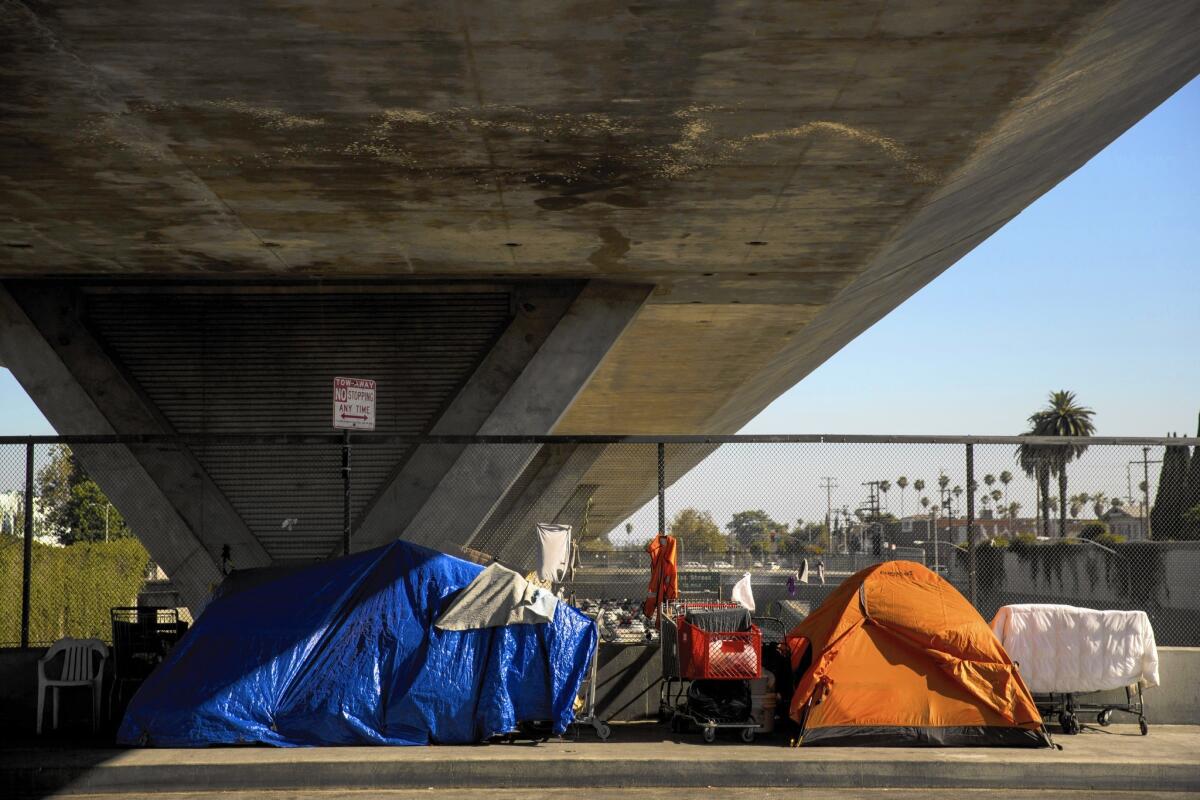13,000 fall into homelessness every month in L.A. County, report says

- Share via
About 13,000 people on public assistance tumble into homelessness every month in Los Angeles County, according to a new study that experts say provides the clearest picture yet of extreme poverty in the region.
Although many quickly find work or rely on family to get off the streets, the number experiencing “continuous, unremitting, chronic homelessness” continues to grow, even after 10,000 people were housed over the last three years, according to the report being released Tuesday by the Economic Roundtable, a nonprofit research group in Los Angeles.
The report recommended that the welfare system intervene to help children and young adults who become homeless before their condition becomes chronic.
“Prevention is critical for reducing the number of people who experience homelessness as well as the number who become chronically homeless,” the study said. “Housing does not provide a solution until the pathways into homelessness are narrowed.”
NEWSLETTER: Get the day’s top headlines from Times Editor Davan Maharaj >>
The group’s analysis was based on records for 9 million county residents who received public assistance at any point between 2002 and 2010. The study said many systems, including disability screening, mental health, foster care and criminal justice, fed into the homelessness pipeline. The 2007 to 2010 recession also drove many out of their homes, it said.
Several homeless service providers said most of these factors had been discussed anecdotally for years, but the report is the first to capture the scale of the problem and predicted it could have a strong impact.
“It is going to be a mover and shaker moment,” said Mollie Lowery of Housing Works. “It really brings home, just the sheer numbers. We’re talking about 13,000 a month. Even me who works in the field had no idea those numbers were out there.”
The latest official homeless count found 44,000 people living in county streets in a three-day period in January, a 12% increase in two years. The survey also found a 37% rise in chronically homeless people. But it has long been acknowledged that many more move in and out of homelessness throughout the year.
The report said the wait in Los Angeles County for Section 8 vouchers, the primary federal resource for low-income housing, was 10 years in 1999. The waiting list closed in 2004, which can only mean the wait has increased, the report said.
Priority for housing goes to people with acute disabilities, the study said, but that leaves out the majority of homeless people, a portion of whom could find work and market-rate rentals if they secured stable housing.
About 42% of people who fall into homelessness do not receive the help they need to remain stably housed, including employment, health and behavioral health services, case management, disability benefits and subsidized housing, the report said.
The report placed particular importance on children, who it said constitute half of all public assistance recipients. Disabilities among children are underreported by 90%, the study found.
It recommended that public assistance offices flag “tripwire events” that are precursors to chronic homelessness, and connect families to agencies that can immediately help resolve their crises.
The warning signs include children not in school regularly, long-term unemployment of the parents and domestic violence.
Other recommendations included:
•Arranging screening for children’s disabilities, including cognitive and mental health issues.
•Screening adults for behavioral health needs.
•Home visits by a public health nurse for any family with children.
•Connecting families to substance abuse rehabilitation services.
The report cautioned that families can be reluctant to interact with authorities for fear of having their children removed from their homes and recommended that services not be “intrusive or sanctioning.”
The study was authored by roundtable President Daniel Flaming and senior researcher Patrick Burns, and funded by the Conrad N. Hilton Foundation.
Twitter: @geholland
ALSO:
Family of man killed by deputies releases witness’ video
The drought’s hidden victim: California’s native fish
Afghan and Iraqi battlefield interpreters begin anew under U.S. visa program
More to Read
Sign up for Essential California
The most important California stories and recommendations in your inbox every morning.
You may occasionally receive promotional content from the Los Angeles Times.











